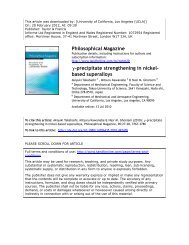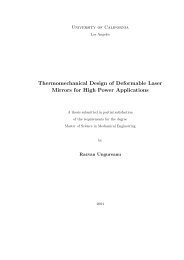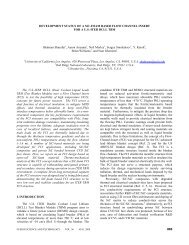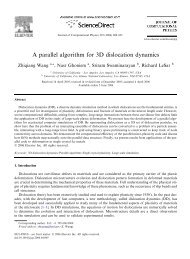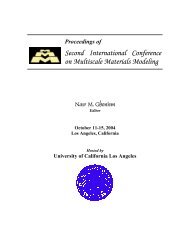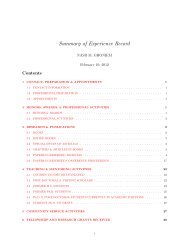Inhibiting Adatom Diffusion through Surface Alloying
Inhibiting Adatom Diffusion through Surface Alloying
Inhibiting Adatom Diffusion through Surface Alloying
- No tags were found...
You also want an ePaper? Increase the reach of your titles
YUMPU automatically turns print PDFs into web optimized ePapers that Google loves.
PRL 105, 015703 (2010) PHYSICAL REVIEW LETTERSweek ending2 JULY 2010<strong>Inhibiting</strong> <strong>Adatom</strong> <strong>Diffusion</strong> <strong>through</strong> <strong>Surface</strong> <strong>Alloying</strong>Zhengzheng Chen, 1 Nicholas Kioussis, 1 King-Ning Tu, 2 Nasr Ghoniem, 3 and Jenn-Ming Yang 21 Department of Physics, California State University, Northridge, California 91330-8268, USA2 Department of Materials Science, University of California, Los Angeles, California 90095-1600, USA3 Department of Mechanical and Aerospace Engineering, UCLA, Los Angeles, California 90095-1597, USA(Received 12 March 2010; revised manuscript received 1 June 2010; published 1 July 2010)Ab initio and kinetic Monte Carlo calculations elucidate the electronic nature of surface Sn alloying onthe stability and mobility of a Cu adatom on the Cu-Sn (111) alloy surface. Sn atoms segregate on thesurface and introduce forbidden areas around them within which adatom adsorption is strictly prohibited.In addition they reduce dramatically both the binding and the mobility of Cu adatoms in neighboringadsorption sites outside the forbidden areas, in contrast to experimental suggestions. Thus, Sn atoms act asblocking sites inhibiting the Cu adatom diffusion. The underlying mechanisms are the structuraldeformation associated with the oversized Sn atoms and the enhancement of the adatom-surfaceinteraction in the vicinity of Sn atoms.DOI: 10.1103/PhysRevLett.105.015703 PACS numbers: 64.60.De, 05.60. k, 71.15.Mb, 73.20. r<strong>Surface</strong> electromigration (EM), involving the diffusionof atoms under the influence of an electric field along thedirection of electron flow, is of a major concern for thereliability of integrated circuits which carry large currentdensities and may exhibit significant mass transport. Thisinduces the formation and migration of voids at the cathodeend of the interconnect, and hillocks at the anode end,leading eventually to failure of the conducting interconnectsin microelectronics technology [1].The microelectronics industry has recently turned tocopper as the interconnect conductor, due to its superiorperformance and reliability, particularly in the context ofits lower electrical resistivity and its intrinsically higherEM resistance [2]. These properties, combined with therecently discovered ultrahigh strength of nanotwin copperwires [3], offers a unique opportunity in producing freestandingcopper interconnects (with air as the lowest kdielectric) in ultralarge-scale integrated circuits. The EMinduced mass transport paths in Cu interconnects at temperaturesof 100 C, and occurs preferentially on the(111) free surfaces or interfaces [4].<strong>Surface</strong> alloying with various metallic elements [5–9]has been employed as an effective way to improve the EMperformance of Cu, with the heavy p-block elements, Sn,Pb, etc., being the best candidates. A 20 nm thick Cu 3 Snintermetallic compound overlayer on the Cu surface wasfound to effectively block dominant surface diffusionpaths, thus resulting in an EM lifetime improvement ofclose to 1 order of magnitude [9]. Recent progress ingrowth techniques of high-quality metallic surface alloysand in real-time microscopy techniques allowing the observationof the time dependence of surface structure inunprecedented detail offers a way to manipulate surfacekinetics. However, in contrast to the well-studied surfaceself-diffusion (homoepitaxial) or the diffusion of atomsdifferent from the substrate (heteroepitaxial), the atomisticmechanisms of kinetics in surface alloys, which can bemuch different from and more complicated than those onthe clean surface, have not been explored adequately.Understanding the origin in the electronic structure ofsurface-atom transport in alloy surfaces may provide guidingrules for the design of novel interconnect materialswith superior EM resistance properties [10]. However,identifying the kinetic processes in surface alloys is computationallyextremely demanding, because of the complexdiffusion energy landscape, inherent in multispecies atoms,involving numerous inequivalent migration paths [8]. Eventhough extensive experimental studies have been carriedout on the effect of Sn alloying on the Cu surface [2,9], theunderlying mechanisms that control the kinetics remainunresolved.In this Letter, we employ ab initio and kineticMonte Carlo calculations to understand the electronic natureof surface Sn alloying on the stability and mobility of aCu adatom on the Cu-Sn (111) alloy surface, in the diluteSn and ordered Cu 3 Sn limits. We demonstrate that substitutionalSn atoms segregate on the surface and introduceforbidden areas (FAs) around them within which adatomadsorption is strictly prohibited. Sn surface atoms alsoreduce dramatically both the binding and the mobility ofCu adatoms in their neighboring adsorption sites outsidethe FAs. The combination of these two effects renders Snatoms blocking sites which inhibit the Cu adatom diffusion.The underlying mechanism is the interplay of (i) astructural effect associated with the oversized Sn atomsleading to severe atomic distortions, and (ii) an electroniceffect associated with the enhancement of both the adatomsurfaceinteraction and the local density of states (LDOS)at the Fermi energy (E F ) in the vicinity of Sn.The ab initio calculations were carried out employingthe VASP code [11,12] with the generalized gradient approximation[13] for the exchange and correlation functionaland the projected augmented wave approach [14] torepresent the electron-ion interaction. The Brillouin-zone0031-9007=10=105(1)=015703(4) 015703-1 Ó 2010 The American Physical Society
PRL 105, 015703 (2010) PHYSICAL REVIEW LETTERSweek ending2 JULY 2010integration was performed with a 3 3 1 k-pointMonkhorst-Pack mesh [15]. The Cu(111) surface wasmodeled employing the slab supercell approach consistingof five 5 5 and 7 7 atomic (111) layers and a 10.5 Åthick vacuum region separating the periodic slabs.Optimized atomic geometries are achieved when forceson all the unconstrained atoms on the top three layers aresmaller in magnitude than 0:02 eV= A. [16] The nudgedelastic band method [17,18] was used to compute thediffusion pathways and migration barriers of a Cu adatomon the Cu-Sn (111) alloy surface. We have used threereplicas between the initial and final geometries to producea smooth minimum energy path.The formation energy, E f , of a substitutional Sn atom onthe surface, subsurface, and third layer below the surface is0:81 eV, 4.26 eV, and 4.4 eV, respectively, with thenegative sign denoting stable formation. Thus, the Snatom can be incorporated solely into the surface layer. Inorder to understand the nature of the interaction betweentwo surface Sn atoms, we list in Table I the change in thetotal energy between two nth nearest-neighbor (NN) tinsand that of the first NN as a function of their separation. Wefind that the first NN Sn-Sn pair is a highly unfavorableconfiguration, in agreement with experiment [19]. Thetrend of both E f and Sn-Sn interaction can be attributedto the oversized Sn atoms which are 20% larger than Cuatoms. Thus, Sn atoms prefer to segregate to and protrudefrom the surface by 0.6 Å to accommodate the size mismatch,creating a tensile strain in the surrounding regionand a Sn-Sn repulsion so as to decrease the elastic energy.The Sn-Sn interaction does not change appreciably beyondthe 2nd-NN separation, indicating that for a fixed Sncoveragethere are several stable configurations of Snatoms on the alloy surface.Figure 1 shows the energy landscape for adsorption of aCu adatom on the Cu-Sn (111) alloy surface which has two4th-NN Sn atoms. The higher energy values in the vicinityof the Sn sites correspond to weaker Cu adsorption. Theabsence of local energy minima at the threefold hollowsites which are NN to Sn demonstrates that these sitesbecome unstable for adsorption due to the protrusion ofthe Sns from the surface.p ffiffiffiConsequently, each Sn introducesFAs of radius r f ¼ð 2 =2Þa0 (a 0 is the Cu lattice constant)centered on it, within which a Cu adatom is strictly prohibitedto adsorb. Thus, Sn atoms act as adsorption blockingsites which impede the adatom diffusion. Similarly, theorigin of the weaker adsorption sites in the vicinity of Snlies on the larger size of the embedded Sn atoms which inturn repel their 1st-NN Cu atoms and hence reduce theavailable volume for adsorption. Interestingly, while surfaceSn atoms bind strongly with in-plane NN Cu atomsleading to E f < 0, they do not bind with NN Cu adatoms,contrary to experimental suggestions [9]. These results,consistent with those of Anderson et al. for the Cu-Pballoy surface [8], suggest that the size mismatch betweenthe heavy p block and Cu plays an important role intailoring surface diffusivity.We have investigated two adatom diffusion paths on theCu (111) surface alloyed with two 4th-NN Sn surfaceatoms, shown in Fig. 2(a). The first (I) migration path isin the vicinity of only one Sn atom, while the second (II)one is in between the two Sn atoms, respectively. The largeyellow (gray) circles denote the Cu (Sn) surface atoms,while the midsize (green) and small (red) circles denotehcp and fcc adsorption sites, labeled by Greek and Latinletters, respectively. The two dark shaded areas centered oneach Sn atom denote the FAs. The landscape of the minimumenergy path along the I and II pathways is shown inFig. 2(b), where the initial adatom position is denoted byan arrow. The values of the diffusion barrier, E m , between various inequivalent fcc and hcp sites, not shown inFig. 2(b), are listed in Table II. E i f (E f) is 2.97 (2.96) eV,and E d$ m is 48.3 meV, both in agreement with the valuesfor the clean Cu (111) surface. The Sn atoms have asubstantial effect on both the potential energy and themigration energy of the adsorption sites which are withinthe light shaded region in Fig. 2(a). For both pathways,there is an increase (ranging from 60 to 130 meV) in thepotential energy for Cu adsorption on the 2nd- and 3rd-NNsites (, c, , e, ", f, ) with respect to the Sn atoms. Inaddition, the migration barrier between these fcc and hcpsites (outside the FAs) increases to 84–99 meV, clearlydemonstrating that the Cu adatom mobility close to Sn issubstantially reduced. The asymmetric shallow energyminima associated with the 3rd-NN hcp site suggests thatat room temperature the Cu adatom can easily diffusebackward away from the Sn atom. The enhancement ofthe blocking propensity associated with the Sn pair is dueTABLE I. Change in total energy between two nth NN Snatoms and that of first NN as a function of their separation.nth NN 1 2 3 4 5 6E (meV) 0 368 394 407 395 407015703-2FIG. 1 (color online). Landscape of change in the total energyof a Cu adatom on the Cu (111) surface alloyed with two 4th-NNSn atoms. The brighter (darker) regions denote weak (strong)adsorption sites.
PRL 105, 015703 (2010) PHYSICAL REVIEW LETTERSweek ending2 JULY 2010FIG. 2 (color online). (a) Migration paths I and II for a Cuadatom on the Cu-Sn (111) alloy surface with two 4th-NN Snsurface atoms. Yellow (gray) circles denote the Cu (Sn) atoms,while green (red) circles labeled by Greek (Latin) letters denotehcp (fcc) sites. (b) Migration energy landscape for paths I and IIversus reaction coordinates. (c) LDOS (E F ) contour plot, wherebright (dark) color indicates high (low) LDOS values. (d) and(e) Migration path and energy landscape for the Cu 3 Sn=Cuinterface denoted by dotted line.to the concerted formation of low-mobility areas betweenSn atoms.The migration path (III) and corresponding energylandscape for the Cu 3 Sn=Cu mixed surface is shown inFigs. 2(d) and 2(e), respectively. Because the h110i Cu-Sn-Cu atomic rows in the ordered Cu 3 Sn surface consist of2nd-NN Sn atoms, both the connectivity of the FAs centeredon Sn and the low-mobility areas between Sn atomsincrease, leading to the blocking of the 1st-NN fcc $ hcp( ! f, f ! , etc.) migration paths available in the dilutecase, thus reducing the diffusion dramatically.Two important factors are responsible for the lowmobilityareas around the Sn atoms (outside the FAs) inFig. 2(b). First is that these are weak adsorption sites andsecond is the increase of E m between these sites. Theformer effect arises from the severe distortions of theatomic configurations due to the oversized Sn atoms.Ab initio calculations for the clean Cu surface constrainedto have an identical atomic displacement field as the Cu-Sndilute alloy surface yields E e$" m ¼ 45 eV, about half itsvalue in Fig. 2(b), suggesting that the second effect is ofelectronic origin. Indeed we find that the strongSn=p-Cu=d surface hybridization (i) lowers and broadensthe upper peak of the LDOS of the Cu surface atoms whichare 1st-NN to Sn and (ii) increases the LDOS (E F ), of s-pcharacter, in the vicinity of Sn. Sn decreases (increases) theheight (width) of the adatom’s LDOS whose center shiftstowards lower energy. Using the Newns-Anderson model[20] and the ab initio determined LDOS, we find that thelarger E m is due to the increase by a factor of 2 of theadatom-d–surface-d interaction in the vicinity of Sn atoms.Moreover, the increase (decrease) of the LDOS (E F ), alsoentering the Newns-Anderson model, from iðfÞ to fðhÞalong path II correlates well with the variation of E m inFig. 2(c), suggesting that the confinement of the surfaceelectrons may also play a role [21].Using the ab initio calculated E m of all inequivalentpaths, we have carried out kinetic Monte Carlo simulations[22,23] to study the temperature-dependent diffusion of aCu adatom on (i) the dilute Sn-pair alloyed surface, and(ii) the Cu 3 Sn=Cu surface consisting of an ordered Cu 3 Snand a clean Cu phase. The probability distribution for a Cuadatom adsorption for these two cases is shown inFigs. 3(a)–3(c) and in Figs. 3(d)–3(f) at 300 K, 600 KTABLE II. Values of migration barrier, E m , of various inequivalentpaths of the Cu adatom on the Cu-Sn surface alloy withtwo 4th-NN Sn atoms. The labels are shown in Fig. 2(a), and thesuperscripts ‘‘atop’’ and ‘‘ex’’ represent migration paths over theatop site or exchanges with a surface atom in the dilute andordered alloy cases.Migration path E fcc!hcpm (meV) E hcp!fccm (meV)fcc $ hcp (pure Cu) 48.3 41.7a $ 1 1b $ 42.1 78.9c $ 7.0 36.5e $ 29.7 37.4g $ 51.4 27.4b atop $ 427.7 421.1b$ ex 1289.1 1282.5g atop $ " (Cu 3 Sn=Cu) 443.1 442.3015703-3FIG. 3 (color online). Probability distribution (logarithmicscale) for a Cu adatom on the Cu (111) surface at 300 K,600 K, and 1000 K, respectively, for (i) the dilute Sn-pair alloyedsystem [(a)–(c)], and (ii) the surface consisting of an orderedintermetallic Cu 3 Sn and a clean Cu phase (Cu 3 Sn=Cu) [(d)–(f)].The gray circles denote Sn atoms.
PRL 105, 015703 (2010) PHYSICAL REVIEW LETTERSweek ending2 JULY 2010and 1000 K, respectively. Employing ab initio calculationsand the harmonic transition state theory [23], the diffusionattempt frequency 0 ¼ 1:6 THz for clean Cu.In the dilute Sn-pair alloy, the diffusion channel for theCu adatom between the two Sn atoms is closed at 300 Kdue to the FAs and low-mobility areas between the Snatoms in Fig. 2(a). Thus, the Sn pair hinders the Cu adatomdiffusion redirecting it away from or around it. This diffusionpath opens with increasing temperature. Nevertheless,even at 1000 K, where the migration rate fcc$hcp is reducedby a factor of 2 compared to that in clean Cu, theblocking effect of Sn remains noticeable.The blocking effect of Sn on adatom diffusion becomesmuch highly pronounced in the Cu 3 Sn=Cu surface, shownin Figs. 3(d)–3(f). Because of the exclusion of the 1st-NNpaths, the Cu adatoms are forced to diffuse solely <strong>through</strong>atop site and/or exchange migration paths [b $ or g $" in Figs. 2(a) and 2(d) and Table II], with an energy barrierof about 15 meV higher than in pure Cu. Thus, Sn surfaceatoms increase not only the energies of both the fcc and hcpsites but also the energy at the saddle points due to the factthat the adatom is farther away from the surface. Themigration rates of these two paths, of 10 7 THz and10 21 THz at 300 K, respectively, are extremely lowcompared with that of 0.25 THz on the clean Cu (111)surface, thus inhibiting the adatom diffusion on the Cu 3 Snphase. Even though more diffusion channels become availableat 600 K, the average probability distribution foradatom adsorption remains low. At 1000 K the thermalenergy of the adatom is large enough to overcome themigration barrier of the 2nd-NN fcc $ hcp path and themigration rates fcc$hcp of the two paths increase to10 2 THz and 10 6 THz, respectively, which, however,are much smaller than in pure Cu. Consequently, at1000 K the Cu adatom diffuses in the Cu 3 Sn phase, butwith an extremely low mobility. The average lifetime of theCu adatom on the available adsorption sites in Cu 3 Sn is200 times longer than that in pure Cu, indicating that theordered Cu 3 Sn structure is an excellent electromigrationinhibitingcandidate.In summary, we have shown that substitutional surfaceSn atoms introduce FAs within which adatom adsorption isstrictly prohibited. Even though surface Sn atoms bindstrongly with NN surface Cu atoms, they do not bindwith the NN Cu adatoms, in contrast to experimentalsuggestions. Sn surface atoms reduce dramatically boththe binding and the mobility of Cu adatoms in neighboringadsorption sites outside the FAs. Thus, Sn atoms act asblocking sites impeding the Cu adatom diffusion. Theunderlying origin is the structural deformation associatedwith the large size of Sn atoms and the enhancement of theadatom-surface interaction in the vicinity of Sn. The monolayeror few layers thick Cu 3 Sn surface enhances furtherthe blocking propensity, rendering it an excellent overlayercandidate in improving the surface EM resistance of Cuinterconnects. This work opens up the possibility of controllingadatom diffusion <strong>through</strong> selective alloying withvarious elements in the p block.We acknowledge valuable discussions with A. R.Akbarzadeh and the support by NSF-NIRT GrantNo. CMS-0506841 and NSF-PREM Grant No. DMR-00116566.[1] A. V. Vairagar et al., Appl. Phys. Lett. 85, 2502 (2004).[2] K. N. Tu, J. Appl. Phys. 94, 5451 (2003).[3] L. Lu, Y. Shen, X. Chen, L. Qian, and K. Lu, Science 304,422 (2004).[4] K. C. Chen, W. W. Wu, C. N. Liao, L. J. Chen, and K. N.Tu, Science 321, 1066 (2008).[5] P. J. Ding, W. A. Lanford, S. Hymes, and S. P. Murarka, J.Appl. Phys. 75, 3627 (1994).[6] C. K. Hu and B. Luther, Mater. Chem. Phys. 41, 1 (1995).[7] C. Cabral, J. M. E. Harper, K. Holloway, D. A. Smith, andR. G. Schad, J. Vac. Sci. Technol. A 10, 1706 (1992).[8] M. L. Anderson, N. Bartelt, P. Feibelman, B.Swartzentruber, and G. Kellogg, Surf. Sci. 600, 1901(2006).[9] M. Y. Yan, J. O. Suh, F. Ren, and K. N. Tu, Appl. Phys.Lett. 87, 211 103 (2005).[10] E. T. Ogawa, K. D. Lee, V. A. Blaschke, and P. S. Ho, IEEETrans. Reliab. 51, 403 (2002).[11] G. Kresse and J. Hafner, Phys. Rev. B 47, 558(R) (1993).[12] G. Kresse and J. Furthmüller, Phys. Rev. B 54, 11169(1996).[13] J. P. Perdew, K. Burke, and M. Ernzerhof, Phys. Rev. Lett.80, 891 (1998).[14] P. E. Blöchl, Phys. Rev. B 50, 17 953 (1994).[15] H. J. Monkhorst and J. D. Pack, Phys. Rev. B 13, 5188(1976).[16] Results for a 8 8 supercell show that the outermost shellatomic displacements are 0:008 A and the largest energydifference in Table I is 2 meV.[17] G. Henkelman, B. P. Uberuaga, and H. J. Jónsson, J.Chem. Phys. 113, 9901 (2000).[18] D. Sheppard, R. Terrell, and G. Henkelman, J. Chem.Phys. 128, 134 106 (2008).[19] A. K. Schmid, N. C. Bartelt, and R. Q. Hwang, Science290, 1561 (2000).[20] A. Groß, in Theoretical <strong>Surface</strong> Science: A MicroscopicPerspective (Springer, Berlin, 2009), 2nd ed., p. 112.[21] N. N. Negulyaev, V. S. Stepanyuk, L. Niebergall, P. Bruno,W. Hergert, J. Repp, K.-H. Rieder, and G. Meyer, Phys.Rev. Lett. 101, 226601 (2008).[22] M. Ziegler, J. Kröger, R. Berndt, A. Filinov, and M.Bonitz, Phys. Rev. B 78, 245427 (2008).[23] A. F. Voter, in Radiation Effects in Solids, edited by K. E.Sickafus, E. A. Kotomin, and B. P. Uberuaga (Springer,NATO Publishing Unit, Dordrecht, The Netherlands,2006), p. 1.015703-4



